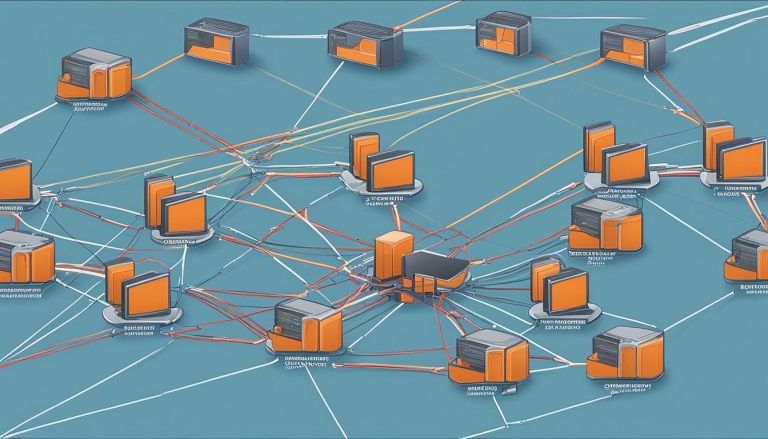I’m here to help you understand the fundamentals of data modeling and its significance in today’s data-driven world. In this article, I will explain the concept of data modeling and its various techniques and types. So, let’s dive in!
Data Modeling is the process of assigning relational rules to data in order to organize it into useful information that organizations can use for decision-making and strategy. By creating a conceptual representation of data objects and their relationships, data modeling establishes data semantics and consistency constraints. This process improves data quality, collaboration, and efficiency, making it crucial for organizations to become more data-driven.
Key Takeaways:
- Data modeling organizes data into useful information for decision-making and strategy.
- It involves creating a conceptual representation of data objects and their relationships.
- Data modeling improves data quality, collaboration, and efficiency.
- There are three main types of data models: Conceptual, Logical, and Physical.
- Data modeling has benefits such as improved understanding of data and enhanced collaboration.
What is a Data Model?
A Data Model is an abstract representation that allows the further building of conceptual models and sets relationships between data items. It serves as a blueprint for organizing and structuring data, providing a framework for understanding how different data elements relate to each other.
The Data Model provides a data description that defines the structure, semantics, and consistency constraints of the data. It defines entities, attributes, and relationships, helping organizations establish a common understanding and vocabulary for their data. By defining the data in a standardized format, the Data Model ensures accurate interpretation and consistent usage of data across different systems and applications.
“A Data Model is like a roadmap that guides organizations in organizing and managing their data effectively. It allows them to define data elements, assign rules, and establish relationships, ensuring the accuracy and integrity of their data.”
A proper Data Model is essential for organizations to make informed decisions and gain actionable insights from their data. It certifies actionable downstream results, knowledge of best practices, and the best tools to access and analyze data. With a well-defined Data Model, organizations can efficiently store, retrieve, and manipulate data, enabling them to derive meaningful information and drive business growth.
| Type | Description |
|---|---|
| Conceptual Data Model | High-level representation of entities and their relationships |
| Logical Data Model | Defines the structure of data entities and their relationships |
| Physical Data Model | Describes the implementation details using a specific DBMS system |
In summary, a Data Model is a crucial tool for organizations to organize and understand their data. It provides a framework for data description, semantics, and consistency constraints, ensuring accurate interpretation and consistent usage of data across different systems. By leveraging a proper Data Model, organizations can effectively manage and analyze their data, leading to improved decision-making and business success.
Data Modeling Process
The Data Modeling process is a crucial step in organizing and structuring data to meet the needs of organizations. It involves several stages that help define the requirements, design the data model, and implement it effectively. Here, I will walk you through each step of the Data Modeling process, highlighting their importance and relevance.
Requirements Gathering
The first step in the Data Modeling process is requirements gathering. In this stage, data modelers work closely with stakeholders to understand their needs and identify the key requirements for the data model. This involves conducting interviews, workshops, and analyzing existing data sources to gather essential information about the organization’s data structures, relationships, and business rules.
- Interview stakeholders to understand their data needs and requirements.
- Analyze existing data sources to identify relevant data structures and relationships.
- Document the requirements and ensure clarity and alignment with stakeholder expectations.
Conceptual Design
Once the requirements are gathered, the next step is the conceptual design of the data model. In this stage, data modelers create a high-level representation of the data objects and their relationships. The conceptual design focuses on capturing the essence of the data and establishing the semantic meaning and relationships between the entities.
“The conceptual design lays the foundation for the data model, providing a clear understanding of the data objects and their relationships.” – John Smith, Data Modeling Expert
Logical Design
After the conceptual design, the logical design stage involves translating the conceptual model into a more detailed and structured representation. Here, data modelers define the structure of the data entities, their attributes, and the relationships between them. The logical design focuses on capturing the business requirements and ensuring the accuracy and integrity of the data model.
| Logical Design | Key Activities |
|---|---|
| Define data entities | Identify and define the main entities and their relationships. |
| Establish attributes | Define the attributes and their characteristics for each entity. |
| Establish relationships | Define the relationships and dependencies between the entities. |
Physical Design
Once the logical design is complete, the next step is the physical design. In this stage, data modelers focus on translating the logical design into a physical implementation. This involves defining the actual database schema, table structures, data types, and constraints that will be used to store and manage the data.
- Translate logical design to physical schema
- Define database tables, fields, data types, and constraints
- Ensure alignment with the selected database management system
Implementation
The final step in the Data Modeling process is implementation. At this stage, the data model is implemented in the selected database management system or data storage solution. This involves creating the database schema, tables, and relationships according to the defined physical design. The implementation process ensures that the data model is accurately translated into a functioning database system.
| Implementation | Key Activities |
|---|---|
| Create database schema | Translate the physical design into a functioning database schema. |
| Create tables and relationships | Create the required database tables and establish the relationships between them. |
| Validate and test | Validate the data model implementation and perform thorough testing to ensure accuracy and reliability. |
By following these steps in the Data Modeling process, organizations can effectively organize and structure their data, enabling better decision-making and improved efficiency in data management.
Types of Data Modelling
Data modelling encompasses various techniques and approaches to represent and organize data. Let’s explore the three main types of data models: Conceptual, Logical, and Physical.
Conceptual Data Model
The Conceptual Data Model provides a high-level view of data entities, attributes, and their relationships. It focuses on the overall understanding and semantics of the data, without delving into implementation details. This type of data model is often used to communicate with stakeholders and capture their requirements and expectations.
Logical Data Model
The Logical Data Model defines the structure and relationships of data entities in more detail. It represents the logical organization of data and serves as a blueprint for the physical implementation. This model helps bridge the gap between business requirements and technical implementation, ensuring that the data accurately reflects the business domain.
Physical Data Model
The Physical Data Model describes how the data is implemented in a specific database management system (DBMS). It includes details such as table structures, data types, indexes, and constraints. This model is concerned with optimizing data storage, performance, and security at the physical level.
| Data Model Type | Description |
|---|---|
| Conceptual Data Model | High-level representation of data entities and their relationships |
| Logical Data Model | Detailed structure and relationships of data entities |
| Physical Data Model | Implementation details specific to a DBMS |
Benefits and Limitations of Data Modeling
Data modeling offers a range of benefits that can significantly enhance an organization’s data management and decision-making processes. One of the key advantages is the improved understanding of data. By creating a conceptual representation of data objects and their relationships, data modeling enables stakeholders to gain insights into the structure and meaning of the data they work with. This understanding facilitates better decision-making, as data can be interpreted more accurately and used to drive strategic initiatives.
Another benefit of data modeling is the improved data quality it promotes. By establishing relational rules and data semantics, organizations can ensure that their data is accurate, consistent, and reliable. This enhances the overall integrity of the data, making it more trustworthy and valuable for decision-making purposes. Additionally, data modeling facilitates improved collaboration among teams and departments within an organization. By providing a shared understanding of data structures and relationships, data modeling enables seamless communication and collaboration across different functions, enhancing efficiency and promoting cross-functional alignment.
While data modeling offers numerous advantages, it also has its limitations. One limitation is limited flexibility in adapting to changing requirements. Once a data model is established, it can be challenging to modify it to accommodate new data elements or changing business needs. This can hinder organizations from quickly responding to evolving data requirements and may require significant effort to make adjustments to the existing model.
Another limitation of data modeling is its complexity. Developing and maintaining data models requires expertise and specialized knowledge, which may be time-consuming and resource-intensive. It requires collaboration between data modelers, stakeholders, and IT teams, adding complexity to the process. As a result, implementing data models can be time-consuming, often requiring iterations and revisions to ensure accuracy and alignment with organizational needs.
Benefits of Data Modeling:
- Improved understanding of data
- Improved data quality
- Improved collaboration
- Increased efficiency
Limitations of Data Modeling:
- Limited flexibility in adapting to changing requirements
- Complexity
- Time-consuming
In summary, data modeling offers valuable benefits that empower organizations to leverage their data effectively. It improves data understanding, quality, collaboration, and efficiency. However, it also has limitations, such as limited flexibility, complexity, and time-consuming implementation. By understanding both the advantages and limitations of data modeling, organizations can make informed decisions regarding its implementation and leverage its capabilities to drive data-driven success.
Conclusion
After understanding the basics of data modeling and exploring its various techniques and types, it becomes evident that data modeling is of utmost importance in today’s data-driven world. By organizing data and establishing relationships between entities, data modeling enables organizations to make informed decisions based on accurate and reliable information.
Data modeling offers numerous benefits to organizations. Firstly, it improves data integrity and ensures data quality, making it more trustworthy and reliable for decision-making processes. Additionally, data modeling fosters improved collaboration among stakeholders, allowing for better communication and understanding of data across different teams and departments. This collaboration leads to increased efficiency in development processes and helps organizations optimize their data management strategies.
However, it is important to acknowledge the limitations of data modeling. Adapting to changing requirements can be challenging due to the limited flexibility of established models. Furthermore, the complexity of data modeling may require additional time and effort to fully understand and implement. Despite these limitations, the benefits of data modeling far outweigh the challenges, making it an essential tool for organizations aiming to leverage their data effectively and become more data-driven in their decision-making processes.
FAQ
What is Data Modeling?
Data Modeling is the process of assigning relational rules to data in order to organize it into useful information that organizations can use for decision-making and strategy.
What is a Data Model?
A Data Model is an abstract representation that allows the further building of conceptual models and sets relationships between data items.
What is the Data Modeling Process?
The Data Modeling process involves several steps, including requirements gathering, conceptual design, logical design, physical design, and implementation.
What are the types of Data Modeling?
There are three main types of data models: Conceptual, Logical, and Physical.
What are the benefits and limitations of Data Modeling?
Data modeling offers benefits such as improved understanding of data, enhanced data quality, improved collaboration, and increased efficiency. However, it also has limitations such as limited flexibility in adapting to changing requirements, complexity in understanding and collaboration, and time-consuming implementation.
Jana is a public relations specialist and writes about all kinds of software products that make our life easier.


